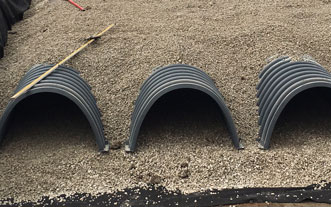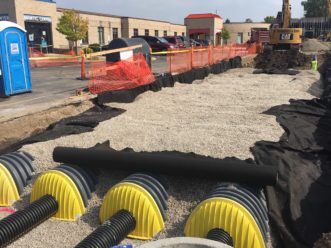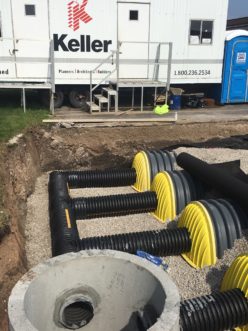Prinsco HydroStor Chamber featured in Stormwater Magazine

February 2, 2018
Stormwater Magazine recently featured an underground storage system designed with HydroStor chambers on the cover of their March/April issue. They highlight the use of Prinsco’s HydroStor HS75 chambers and GoldFlo WT® pipe in the Aquatic Center Parking Lot Project located in the Village of Allouez, Wisconsin. Read more about it in the excerpt below or find the entire article in the Stormwater Magazine digital edition.
Making Room for Runoff
Underground storage and detention systems help developers carve out extra space
By Janet Aird
(excerpt starting on pg. 32)
Aquatic Center Parking Lot, Village of Allouez


In May 2017, work began on an addition to and renovation of the Cerebral Palsy Aquatic Center in the Village of Allouez, WI, which is bordered by Green Bay. The center, which has two warm-water pools and a whirlpool, is increasing its services for adults, therapy, and childcare, as well as its office space.
The center lies on 4.78 acres on a ridge. The slopes are gentle, and there are no serious rain events, flooding, or contaminated stormwater. The East River, on the eastern side of the site, is a tributary of Fox River, on the western side.
The center is in an older part of town with a residential area on one side, a commercial area with classic homes on another, and a highway and a prison on the two other sides, says Wally Wildenberg, who oversaw the installation of the underground stormwater detention system for Keller Inc.
The approximately 21,404-square foot addition was designed by Somerville Inc. in Green Bay and built by Keller in Kaukauna, WI. Keller also built or reconstructed the driveways, parking lots, sidewalks, and utilities that serve the facility.
The project impacts approximately 2.2 acres of the site, according to the stormwater management and erosion control plan provided by Patrick Kuehl, who designed the detention system. Kuehl is a civil engineer with Robert E. Lee & Associates Inc. in Green Bay.
Among the factors that Kuehl considers when he’s designing a stormwater detention system are the soil type, the slope, the volume of water the site is expected to receive during a 2-year and 100-year storm, the cost, and how the system fits geometrically into the space.
“Finding a system that would fit into the space available at this site was a challenge,” he says. “There is virtually no green space.”
HydroStor HS75 chambers and GoldFlo WT pipes from Prinsco Inc. in Willmar, MN, were chosen. According to Prinsco, the HDPE chambers hold 75 cubic feet of stormwater each and are designed for maximum land utilization and minimum environmental impact. The dual-wall HDPE pipes form the inlet and outlet manifolds. They have watertight integral gasket bell and spigot coupling systems for optimum flow.
The detention chambers are located under the existing parking lot. Their area is 2,673 square feet and the chambers provide a volume of 5,332 cubic feet of storage. They will be largely empty most of the time.
Stormwater from the roof of the building and from the roadway around the building enters catch basins and storm manholes with sumps that collect sediment and phosphorus.
“There was no need for a sediment retention chamber,” says Wildenberg. “It’s basically a clear water system. All of the surface areas that will ultimately shed water to this system are not subject to accumulating sediment. All water that will be collected will have hard surfaces to run on—that is, the private paved roadway around the building, and the roof of the building.”
After this sump treatment, water enters a flow control manhole that directs runoff from up to the 2-year design storm to a 12-inch pipe that discharges to the underground storage chambers. This stormwater is released slowly to a Village of Allouez storm sewer system that carries the water to village-owned Heritage Hill Stormwater Pond for further treatment.
Once the 12-inch pipe reaches maximum capacity, any additional flow is diverted to a 15-inch pipe which discharges to a roadside ditch that carries all of the runoff exceeding the capacity of the underground chambers to the East River.
“We really had to coordinate with the village regarding pretreating and reducing the flow of the stormwater,” says Kuehl. “It was challenging, but working with the village, we came to a solution. The village benefits, too. They were able to redirect stormwater from an adjacent parcel to the pond, increasing the area of development treated by the Heritage Hill Stormwater Pond.”
The site posed its own challenges. Space was limited and the center had to remain open during the installation, he says. In addition, notes Wildenberg, there was little difference between the elevation of the site and of the stormwater treatment pond, so the system had to be as shallow as possible. Fortunately, the soil is mostly clay and tested out as more loadbearing than was needed.
Harold Tauschek & Sons Excavating & Snow Removal Inc. of New Franken, WI, excavated to a depth of 5.5 to 6 feet for the installation of the stormwater chambers. The bottom and sides of the excavations were lined with a non woven geotextile to prevent the soil from migrating into the backfill.
The crew placed and leveled 6 inches of clean 3/4-inch aggregate from offsite around the fabric-encapsulated chambers in order to provide additional storage. A 4-inch perforated perimeter drain-through was connected to the discharge control manhole on the downstream end of the chambers.
Tauschek & Sons then laid a 15-foot-long layer of geotextile on the aggregate on the inlet ends for scour protection from the incoming stormwater. They placed a total of 68 chambers in four runs and then connected the inlet and outlet ends to manholes with Prinsco’s GoldFlo WT pipes.
It’s important to align the chambers and to get the spacing between them right because they interlock, says Wildenberg. In addition, the crew had to be sure to set the plumbing parts properly.
Tauschek & Sons added more backfill around, between, and above the chambers, and wrapped the entire system with the geotextile. “This creates a capsule so the stone also filters the water,” says Wildenberg. The final layer was a bedding layer of crushed gravel on the geotextile, which was covered with pavement. The installation took about three weeks in September 2017. The work went very well, both Wildenberg and Kuehl agree.
The system requires very little maintenance, says Wildenberg. The catch basins and the caps can be cleaned out if necessary.
Excerpt from: Aird, Janet. “Making Room for Runoff, Underground storage and detention systems help developers carve out extra space.” Stormwater Magazine. March/April 2018.
